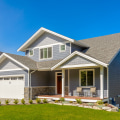Homeowners must consider both design and practicalities when deciding between a sloped roof or a flat roof. In general, a flat roof is more appropriate for areas that receive little rainfall, and a sloped roof is more suitable for wetter climates due to its ability to withstand moisture damage. When it comes to the basic structure of a flat or pitched roof, a sloped roof provides more structure and stability than a flat roof, as well as excellent drainage in areas that receive large amounts of rainfall. Flat roofs are an economical and practical option for those who live in areas that receive little rainfall.
They are also characteristic of modern design, so if you want to design a contemporary home, use a flat roof or a sloped roof with a very low slope. Sloped roofs are more stable than flat roofs during periods of heavy rain and offer much more effective drainage. Water drains easily and evenly from a sloped roof, while on a flat roof, water can accumulate and create structural pressure. Sloped roofs are known for their longevity and durability, so maintenance is often less important compared to flat roofs. Thanks to their design, sloped roofs are also more reliable when it comes to drainage, as water is naturally channeled into downspouts and gutters, and is removed from the property.
Water accumulation poses a lower risk, which can be incredibly important in certain areas. The environment is also a key concern for many these days, and flat roofs can be the ideal canvas for an environmentally friendly green roof. The decision between a sloped roof or a flat roof is important and can have long-term implications for the maintenance and maintenance of the building. To save even more energy, add insulation to the space between the sloped roof and the flat interior roof. Another reason for the durability of sloped roofs is that the greater inclination allows the roof to better withstand water, ice and snow that immediately come off the roof, compared to the lower slope of flat roofs. Flat roofs are faster and easier to install than sloped roofs.
If you're looking for a robust and cost-effective roof for your building, a pitched roof is most likely the best option. Sloped roofs are considered to be the more traditional option, while flat roofs are popular among modern and contemporary designs. Consult with a roofing contractor to determine which roofing option is best for your individual needs. If you're willing to spend a little more on a roof that withstands the elements and provides additional space below the ceiling, a flat roof is probably the best option.
While flat roofs can be built to accommodate foot traffic, sloped roofs can be converted to house a considerable amount of additional living space inside. When it comes down to it, homeowners must weigh up both design and practicalities when deciding between a sloped or flat roof. Sloped roofs offer excellent drainage in areas that receive large amounts of rainfall, while flat roofs are an economical and practical option for those who live in areas that receive little rainfall. Flat roofs are also ideal canvases for green roofs.
Ultimately, consult with an experienced contractor to determine which type of roofing option is best for your individual needs.



